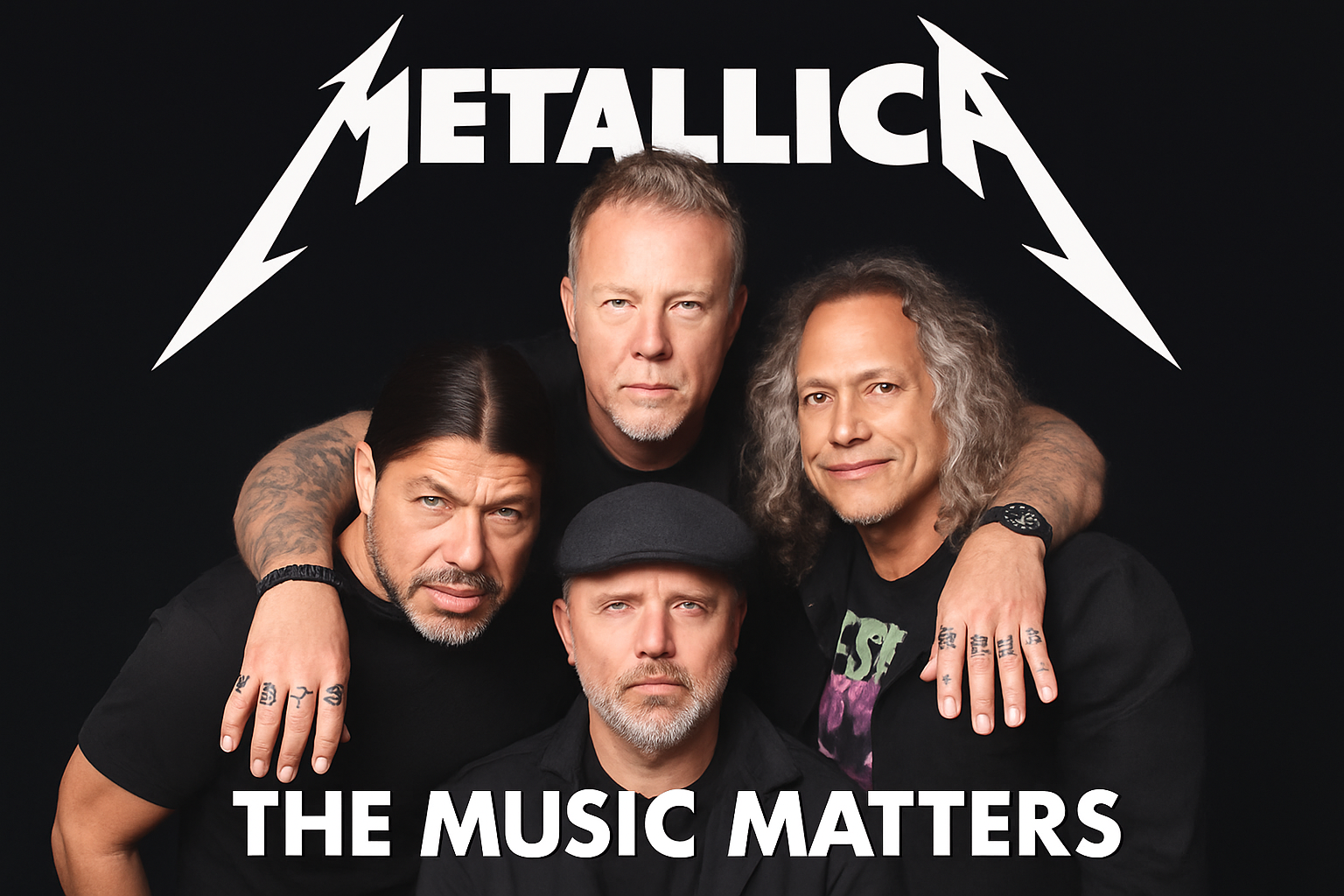London: The arena is electric. It’s 2025, and as darkness falls, 20,000 fans inhale as one, their breath held on the edge of something massive. A single spotlight cuts through the haze. There, center stage, James Hetfield steps forward—cowboy hat low, guitar slung like a weapon. Lars Ulrich’s snare cracks like thunder. Kirk Hammett’s fingers light up the fretboard. Robert Trujillo’s bassline growls like an earthquake. Then, like a detonation: “Seek & Destroy!”
And for two hours, time folds in on itself.
Welcome to Metallica—44 years into their reign, still unapologetically loud, fiercely relevant, and the eternal pulse of heavy metal.
The Birth of Fire (1981–1985)
Rewind to Los Angeles, 1981. Glam rock rules the Sunset Strip, and spandex-clad bands chase pop stardom. But in the margins, something raw is forming. A teenage Danish drummer named Lars Ulrich places a classified ad looking for bandmates. Enter James Hetfield—stoic, intense, a voice born of gravel and rage. Together, they ignite.
By 1983, Kill ‘Em All explodes onto the underground. It isn’t polished; it’s a Molotov cocktail—fast, feral, revolutionary. With Cliff Burton’s virtuosity on bass and Hammett’s speed-demon solos, Metallica pioneers thrash metal’s DNA. Ride the Lightning (1984) shows their evolution—lyrical depth, musical ambition. “Fade to Black” brings introspection; “Creeping Death” delivers fury with biblical scale. This isn’t just noise. It’s art in denim and chains.
Then comes Master of Puppets (1986)—not just an album, but a manifesto. Eight tracks of complexity, ferocity, and brilliance. “Battery,” “Welcome Home (Sanitarium),” and the instrumental opus “Orion” cement Metallica’s place at metal’s mountaintop. Fans respond in kind—leather-clad, moshing, screaming every lyric. This is no longer a band. It’s a tribe.
Tragedy and Triumph (1986–1991)
September 27, 1986. Sweden. The band’s tour bus crashes. Cliff Burton, age 24, is gone.
Metallica is shattered, but not silenced. They channel grief into rage. Jason Newsted joins, and …And Justice for All (1988) arrives like a hammer—complex, unrelenting. “One” becomes a cultural moment, its video slicing into MTV with images of war and trauma. The band, stripped of ornament, plays with blood in their teeth.
Then, a seismic shift: Metallica (1991), known as The Black Album. With producer Bob Rock, the band crafts radio-friendly anthems that still crush. “Enter Sandman” becomes a generational battle cry. “The Unforgiven” adds texture. “Nothing Else Matters”—a ballad? Yes, and it works. The album sells over 30 million worldwide. They aren’t just icons of metal—they’re giants of modern music.
Some fans cry “sellout,” but Metallica doesn’t flinch. They’re playing stadiums now, bringing metal to the mainstream without apology.
Reinvention and Reckoning (1992–2008)
The ’90s challenge Metallica’s identity. Load (1996) and Reload (1997) introduce groove, blues, and personal introspection. Gone are the thrash tempos; in their place, a more brooding, radio-ready sound. Some fans bristle, but tracks like “Until It Sleeps” and “Hero of the Day” show a band unafraid to evolve.
Then comes the fracture. Newsted departs. Hetfield battles addiction. The Napster debacle turns public opinion. The band is mocked, maligned.
Some Kind of Monster (2004), a painfully honest documentary, lays bare their dysfunction. It’s ugly and real—arguments, therapy, breakdowns. And yet, it humanizes them.
St. Anger (2003) is divisive. No solos. A clanging snare. Lyrics raw as an open wound. It’s not pretty, but it’s authentic. This is survival in album form.
Robert Trujillo joins in 2003, bringing soul and groove. Slowly, Metallica rises again.
Ascension and Legacy (2008–2025)
Death Magnetic (2008) is a return to form—a thrash resurrection. “The Day That Never Comes” and “Cyanide” remind the world that Metallica’s fire never died. They don’t follow trends—they torch them.

In 2011, they throw the rulebook away with Lulu, a bizarre collaboration with Lou Reed. Critics are baffled. Some fans recoil. But Metallica doesn’t play it safe—they never have.
Hardwired… to Self-Destruct (2016) delivers the duality of past and present: lightning-fast riffs, sharp songwriting, modern production. “Moth Into Flame” crackles with energy. “Spit Out the Bone” is thrash reborn.
Then comes 72 Seasons (2023). Reflective, heavy, and deeply personal. Songs like “Lux Æterna” and “Screaming Suicide” wrestle with time, trauma, and mortality. It’s their most introspective work yet—written by legends who have walked through fire.
The M72 World Tour, spanning 2023 to 2025, sells out massive stadiums. Every night, tens of thousands chant lyrics that span four decades. This isn’t nostalgia. It’s a living, breathing metal machine.
The Legacy Etched in Steel
What do you say about a band that has sold over 125 million records, won nine Grammys, and reshaped the musical landscape?
From South Park parodies to Stranger Things revivals, from S&M orchestral epics to the Blacklist tribute project featuring artists from Miley Cyrus to St. Vincent—Metallica’s influence crosses genres and generations.
Their foundation, All Within My Hands, raises millions for education and disaster relief. They’ve remained grounded while selling out arenas. They’ve stayed heavy while experimenting. They’ve endured loss, criticism, and cultural shifts.
And still, they stand.
The Metallica Experience
You haven’t lived until you’ve stood in the pit as “Master of Puppets” hits.
The lights flicker. The riff drops like a guillotine. The floor shakes. Your heart syncs to the double bass. Around you: a sea of black T-shirts, raised horns, tears, sweat, catharsis. This is communion. This is therapy. This is rebellion and redemption in four-four time.
For 44 years, Metallica has been more than music. They’ve been a lifeline for the alienated, the angry, the inspired. A thunderous roar against silence. A family of outcasts that spans continents.
Their story isn’t finished—not even close. As long as there’s distortion, as long as there’s fire in the belly and pain to transform into poetry, Metallica will endure.
The amps are humming. The lights are low.
The next song is about to begin.





